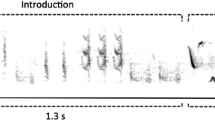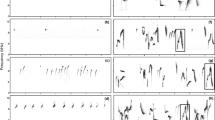Abstract
Empirical descriptions of vocal behaviour are important for understanding avian biology. In this study, we provide the first detailed analysis of the vocal behaviour of the Brown-throated Wren (Troglodytes brunneicollis), a neotropical songbird found in oak forests in the highlands of Mexico and the southwestern United States. We quantify the fine structural characteristics of the song, and describe the size and structure of the song repertoire. Further, we describe diel variation, analyze song-sharing patterns among neighbors, and explore whether this species uses syntactical rules for creating their songs. Our analyses reveal that Brown-throated Wrens have complex songs and simple calls. They sing with eventual variety, repeating songs many times before switching to a new song type. Males combine syllables into phrases to create songs. We show that song repertoire size is not fixed; birds recombine their syllables to produce highly variable song types. Brown-throated Wrens sing with high vocal output after sunrise and song activity declines throughout the morning. Song sharing shows no variation with distance among our sampled individuals. We divide the syllables in Brown-throated Wren songs into 13 categories; birds sing some syllables more frequently than others, and some syllables are more likely to be found at the beginning, middle, or end of the song. Transitions between syllable categories deviate significantly from random chance, and most males analyzed follow similar patterns of syllable transitions, revealing syntactical structure. This research, which provides the first empirical study of Brown-throated Wren song, expands our knowledge of the behaviour of this poorly-studied taxon, and contributes insight into the organization and composition of song in tropical birds.
Zusammenfassung
Das Gesangsverhalten des Braunkehl-Zaunkönigs ( Troglodytes brunneicollis ): Gesangsstruktur, Repertoire, Syntax und tageszeitliche Variationen
Empirische Erhebungen des Gesangsverhaltens sind sehr wichtig für das Verständnis der Biologie von Vögeln. Mit dieser Studie legen wir die erste detaillierte Analyse des Gesangsverhaltens des Braunkehl-Zaunkönigs (Troglodytes brunneicollis) vor, eines neotropischen Singvogels aus den Eichenwäldern des mexikanischen Hochlands und des Südwesten der USA. Wir quantifizieren die Feinstruktur der Gesangsmerkmale und beschreiben Größe und Struktur des Repertoires. Ferner beschreiben wir tageszeitliche Variationen und Gemeinsamkeiten im Gesang von Reviernachbarn und untersuchen, ob diese Art bei der Ausprägung ihrer Gesänge Syntax-Regeln folgt. Unsere Analysen zeigen, dass Braunkehl-Zaunkönige sowohl einfache Rufe als auch komplexe Gesänge besitzen. Sie singen mit nur gelegentlichen Variationen, wobei sie ein Gesangselement oft wiederholen, bevor sie zu einem neuen überleiten. Bei der Zusammenstellung neuer Gesänge kombinieren die Männchen einzelne Tonsilben zu Phrasen. Wir zeigen, dass die Repertoire-Größe nicht festgelegt ist; die Vögel setzen ihre Tonsilben zu immer neuen Gesangstypen zusammen. Die Braunkehl-Zaunkönige haben direkt nach dem Sonnenaufgang eine sehr hohe Gesangsproduktion, die im Laufe des Morgens dann nachlässt. Gemeinsamkeiten im Gesang von Nachbarn erwiesen bei unserer Stichprobe keine besonderen Variationen mit wachsendem Revierabstand. Wir teilen die Tonsilben in 13 Kategorien ein; die Vögel singen manche Tonsilben häufiger als andere, und einige Silben treten jeweils eher am Anfang, in der Mitte oder am Ende eines Gesangs auf. Die Übergänge zwischen den einzelnen Kategorien sind signifikant nicht zufallsverteilt, die meisten der untersuchten Männchen folgen ähnlichen Übergangsmustern, was auf eine syntaktische Strukturierung hinweist. Dies ist die erste empirische Untersuchung des Gesangs von Braunkehl-Zaunkönigen; sie erweitert unser Wissen vom Verhalten dieser nur wenig untersuchten Art und bietet weitere Einsichten in die Organisation und Zusammensetzung der Gesänge tropischer Singvögel.





Similar content being viewed by others
References
American Ornithologists’ Union (1998) Check-list of North America birds, 7th edn. American Ornithological Union, Washington, DC
Bakeman R, Quera V (2011) Sequential analysis and observational methods for the behavioral sciences. Cambridge University Press, Cambridge
Beecher MD, Campbell SE (2005) The role of unshared songs in singing interactions between neighbouring song sparrows. Anim Behav 70:1297–1304
Beecher MD, Campbell SE, Burt JM, Hill CE, Nordby JC (2000) Song-type matching between neighboring song sparrows. Anim Behav 59:21–27
Borror D (1956) Variation in Carolina Wren songs. Auk 73:211–229
Brewer D, MacKay BK (2001) Wrens, dippers and thrashers. Yale University Press, Hong Kong
Brumfield RT, Capparella AP (1996) Genetic differentiation and taxonomy in the House Wren species group. Condor 98:547–556
Camacho-Schlenker S, Courvoisier H, Aubin T (2011) Song sharing and singing strategies in the Winter Wren Troglodytes troglodytes. Behav Process 87:260–267
Catchpole CK (1976) Temporal and sequential organisation of song in the Sedge Warbler (Acrocephalus schoenobaenus). Behaviour 59:226–246
Catchpole CK, Slater PJB (2008) Bird song, biological themes and variation, 2nd edn. Cambridge University Press, Cambridge
del Hoyo A (2005) Handbook of the birds of the world, vol 10. Cuckoo-shikes to thrushes. Lynx, Barcelona
Ersts PJ (2011) Geographic Distance Matrix Generator (version 1.2.3). American Museum of Natural History, Center for Biodiversity and Conservation, New York
Ficken MS, Rusch KR, Taylor SJ, Powers DR (2000) Blue-throated hummingbird song: a pinnacle of nonoscine vocalizations. Auk 117:120–128
Garamszegi LZ, Balsby TJS, Bell BD, Borowiec M, Byers BE, Draganoiu T, Eens M, Forstmeier W, Galeotti P, Gil D, Gorissen L, Hansen P, Lampe HM, Leitner S, Lontkowski J (2005) Estimating the complexity of bird song by using capture–recapture approaches from community ecology. Behav Ecol Sociobiol 57:305–317
Hammer Ø, Harper DAT, Ryan PD (2001) PAST: paleontological statistics software package for education and data analysis. Palaeontol Electron 4:1–9
Holland J, Dabelsteed T, López Paris A (2000) Coding in the song of the wren: importance of rhythmicity, syntax and element structure. Anim Behav 60:463–470
Howell SNG, Webb S (1995) A guide to the birds of Mexico and Northern Central America. Oxford University Press, New York
Hultsch H, Todt D (1989) Memorization and reproduction of songs in Nightingales (Luscinia megarhynchos): evidence for package formation. J Comp Physiol A 165:187–203
Hultsch H, Todt D (2004) Learning to sing. In: Marler P, Slabbekoorn H (eds) Nature’s music: the science of bird song. Elsevier, San Diego, pp 39–79
Johnson LS, Kermott LH (1991) The functions of song in male House Wrens (Troglodytes aedon). Behaviour 116:190–209
Kondo N, Watanabe S (2009) Contact calls: information and social function. Jpn Psychol Res 51:197–208
Krebs CJ (1999) Ecological methodology, 2nd edn. Addison Welsey Educational Longman, California
Kroodsma DE (1977) Correlates of song organization among North American wrens. Am Nat 111:995–1008
Kroodsma DE (1980) Winter Wren singing behavior: a pinnacle of song complexity. Condor 82:357–365
Lapierre JM, Mennill DJ, MacDougall-Shackleton EA (2011) Spatial and age-related variation in use of locally common song elements in dawn singing of song sparrows Melospiza melodia: old males sing the hits. Behav Ecol Sociobiol 65:2149–2160
Leger DW (2005) First documentation of combinatorial song syntax in a suboscine passerine species. Condor 107:765–774
Lynch A (1996) The population memetics of birdsong. In: Kroodsma DE, Miller EH (eds) Ecology and evolution of acoustic communication in birds. Cornell University Press, Ithaca, pp 181–197
Marler P, Slabbekoorn H (2004) Nature’s music: the science of bird song. Elsevier, San Diego
Martínez Gómez JE, Barber BR, Peterson AT (2005) Phylogenetic position and generic placement of the Socorro Wren (Thryomanes sissonii). Auk 122:50–56
Mennill DJ, Vehrencamp SL (2005) Sex differences in singing duetting behaviour of neotropical Rufous-and-white Wrens (Thryothorus rufalbus). Auk 122:175–186
Mennill DJ, Battiston M, Wilson DR, Foote JR, Doucet SM (2012) Field test of an affordable, portable, wireless microphone array for spatial monitoring of animal ecology and behaviour. Methods Ecol Evol 3:704–712
Molles LE, Verhencamp SL (1999) Repertoire size, repertoire overlap, and singing modes in the Banded Wren (Thryothorus pleurostictus). Auk 116:677–689
Morton ES (1987) The effects of distance and isolation on song-type sharing in the Carolina Wren. Wilson Bull 99:601–610
Okanoya K, Yamaguchi A (1997) Adult Bengalese finches (Lonchura striata var. domestica) require real-time auditory feedback to produce normal song syntax. J Neurobiol 33:343–356
Platt ME, Ficken MS (1987) Organization of singing in house wrens. J Field Ornithol 58:190–197
Podos J, Huber SK, Taft B (2004) Bird song: the interface of evolution and mechanism. Annu Rev Ecol Evol Syst 35:55–87
Price JJ (2013) Why is birdsong so repetitive? Signal detection and the evolution of avian singing modes. Behaviour 150:995–1013
Quinn GP, Keough MJ (2002) Experimental design and data analysis for biologists. Cambridge University Press, Cambridge
Ralph CJ, Geupel GR, Pyle P, Martin TE, DeSante DF (1993) Handbook of field methods for monitoring landbirds. Gen. Tech. Rep. PSW-GTR-144-www. Pacific Southwest Research Station, Forest Service, U.S. Department of Agriculture, Albany
Rendall D, Kaluthota CD (2013) Song organization and variability in Northern House Wrens (Troglodytes aedon parkmanii) in western Canada. Auk 130:1–12
Rice NH, Peterson AT, Escalona-Segura G (1999) Phylogenetic patterns in montane Troglodytes wrens. Condor 101:446–451
Rosenberg MS, Anderson CD (2011) PASSaGE: pattern analysis, spatial statistics and geographic exegesis. Version 2. Methods Ecol Evol 2:229–232
Spector DA (1991) The singing behaviour of yellow warblers. Behaviour 117:29–52
Spector DA (1992) Wood-warbler song systems: a review of paruline singing behaviours. Curr Ornithol 9:199–239
Staicer CA, Spector DA, Horn AG (1996) The dawn chorus and other diel patterns in acoustic signalling. In: Kroodsman DE, Miller EH (eds) Ecology and evolution of acoustic communication in birds. Cornell University Press, Ithaca, pp 426–453
Suthers RA (2004) How birds sing and why it matters. In: Marler P, Slabbekoorn H (eds) Nature’s music: the science of bird song. Elsevier, San Diego, pp 272–295
Todt D, Naguib M (2000) Vocal interactions in birds: the use of song as a model in communication. Adv Stud Behav 29:247–296
Valderrama S, Parra J, Davila N, Mennill DJ (2008) Vocal behaviour of the critically endangered Niceforo’s Wren (Thryothorus nicefori). Auk 125:395–401
van Horne B (1995) Assessing vocal variety in the winter wren, a bird with a complex repertoire. Condor 97:39–49
Watson DM (2003) Long-term consequences of habitat fragmentation-highland birds in Oaxaca, Mexico. Biol Conserv 111:283–303
Wright T, Dahlin C (2007) Pair duets in the Yellow-naped amazon (Amazona auropalliata): phonology and syntax. Behaviour 144:207–228
Acknowledgments
We thank O. Rojas-Soto and A. Gordillo for logistical support. We thank A. Vargas, J. Calderón, and M. Ortiz for field assistance, and M. Watson for sound analysis assistance. We thank G. Budney and the Macaulay Library of Natural Sounds for loaning us recording equipment. We thank O. Rojas-Soto for assistance with permits for mist netting birds. This paper was improved by comments from D. Wilson, L. Sandoval, T. Friedl, and two anonymous reviewers. For funding, we thank the Consejo Nacional de Ciencia y Tecnología (CONACyT), Secretaría de Educación Publica de México (SEP), and the University of Windsor for scholarship support to J.R.S.-L., and the Natural Sciences and Engineering Research Council of Canada (NSERC), the Canada Foundation for Innovation, and the Government of Ontario for grants to D.J.M.
Author information
Authors and Affiliations
Corresponding author
Additional information
Communicated by T. Friedl.
Electronic supplementary material
Below is the link to the electronic supplementary material.
Rights and permissions
About this article
Cite this article
Sosa-López, J.R., Mennill, D.J. The vocal behavior of the Brown-throated Wren (Troglodytes brunneicollis): song structure, repertoires, sharing, syntax, and diel variation. J Ornithol 155, 435–446 (2014). https://doi.org/10.1007/s10336-013-1024-6
Received:
Revised:
Accepted:
Published:
Issue Date:
DOI: https://doi.org/10.1007/s10336-013-1024-6




